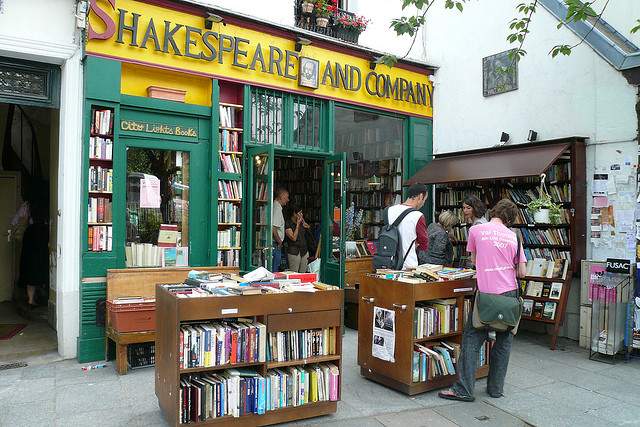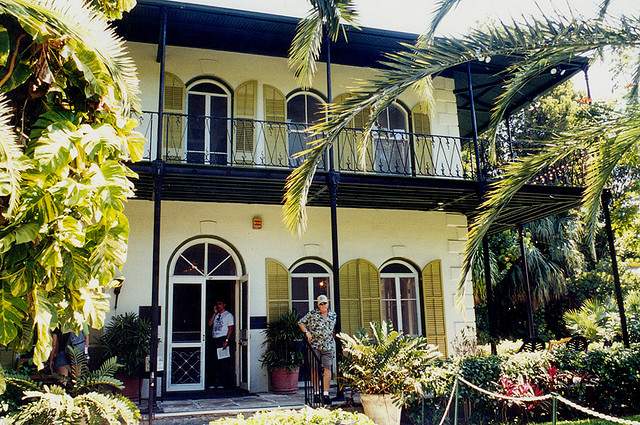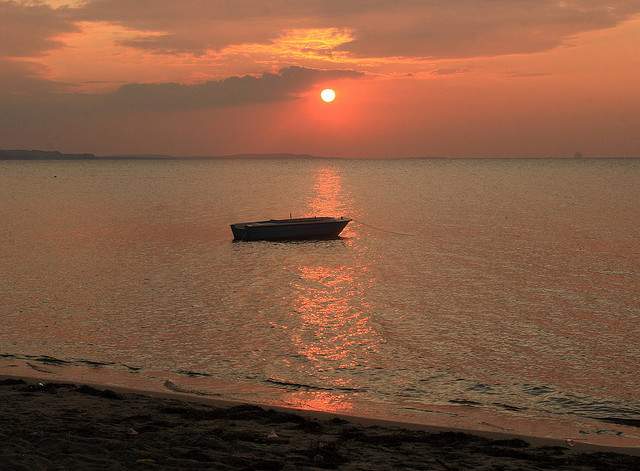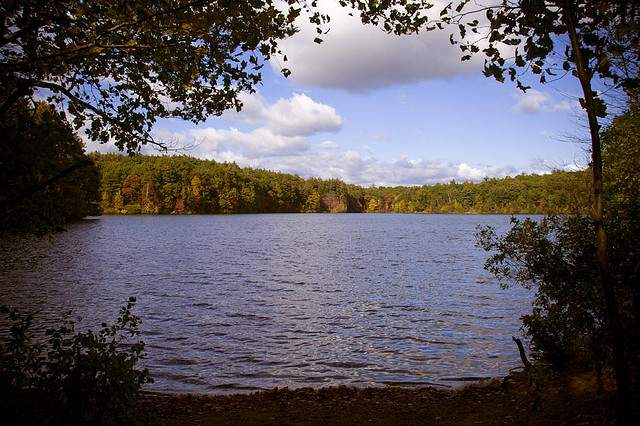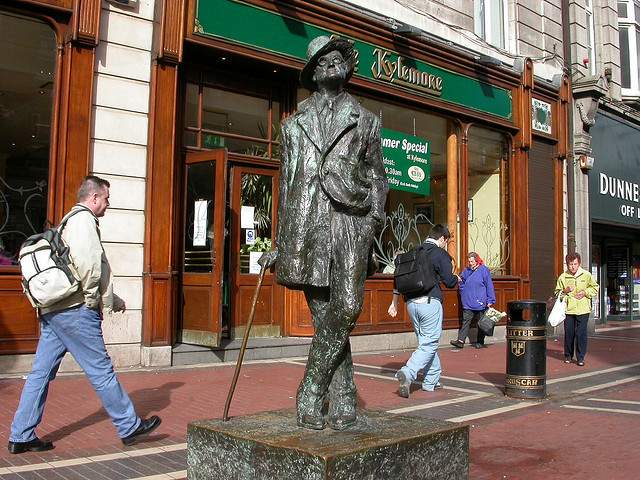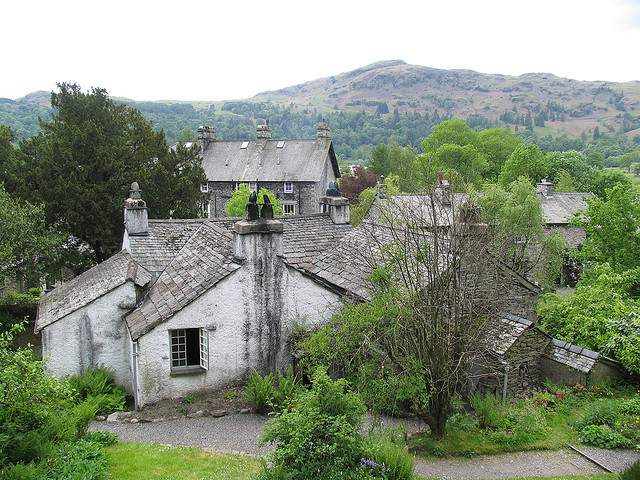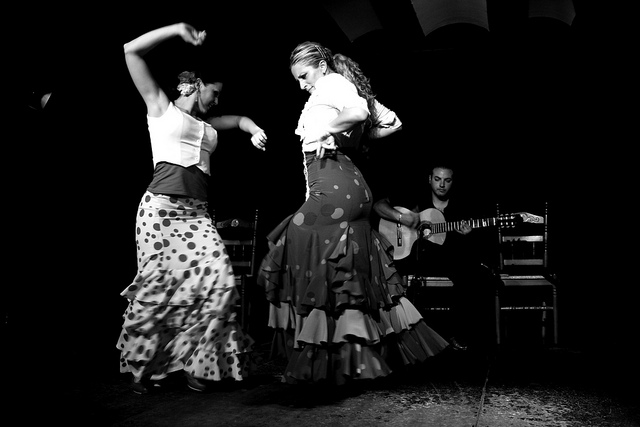The lover should also be a pilgrim. The wine lover should be driven through Napa Valley half-drunk in a convertible, the film buff should visit Hollywood, and the classical music lover should journey to Beethoven’s birth house in Bonn. A pilgrimage is the focal point around which a journey wraps, not the raison d’etre per se (that is the journey itself) but rather the pulley on the far end of the rope that ratchets you out of your home and into the search for your loved one.
So where should the lover of Western Literature pilgrimage? The possibilities are endless; they will also sway heavily according to taste, but here are a possible pilgrimage sites around the world that have played a significant role in the shaping of Western literature.
The Shakespeare and Company Bookshop – Paris
There is perhaps no place more important to the history of Western Literature than “The Illuminated City.” Paris was the stomping ground (and most celebrated and maligned subject) of French writers such as Balzac, Baudelaire, Proust, Flaubert, Molière, Voltaire, Dumas, and well–need I go on? Every French writer of note has spent some portion of their life in this city of cities – and the sculptures of their likenesses, the streets throughout the city claiming their namesakes, and the countless museums made of their homes are a testament to the high esteem in which the French hold their auteurs.
But Paris has also been a magnet for expatriate writers from across the English-speaking world. Irish playwright Samuel Beckett fled Ireland to settle here permanently, as did James Joyce, who first published his earthshaking novel Ulysses under the stamp of The Shakespeare and Company bookshop, the infamous bookstore whose clientele has included many of the most famous writers of the 20th century. If one needed to torpedo the one establishment in Paris no English-speaking Literary enthusiast should miss, it is the Shakespeare and Co. The store’s founder, Sylvia Beach, was on intimate terms with the community of American expat writers of the 1920s, which included Ernest Hemingway, Ezra Pound, F. Scott Fitzgerald and Gertrude Stein, among others. The shop was shut down by the Nazis but George Whitman, who established the Le Mistral bookstore ten years later (in front of which Lawrence Ferlinghetti, Gregory Corso, William S. Burroughs and Allen Ginsberg once shouted out their poetry to passersby) renamed his establishment “Shakespeare and Company” after Sylvia Beach’s death and has since sought to continue its legacy.
Writers are welcome to sleep in the bookstore for free as long as they help out with chores and write about their experience. Be sure to buy a book to help keep the establishment going, and ask about the Literary Walking tours around Paris, which can be arranged for around 50 euros. There are also weekly readings from published authors. For more information check out their website.
>> Find English language bookshops in Paris
Ernest Hemingway House – Key West
Sure, it’s an island paradise with beautiful beaches and great fishing, but Key West is also a wonderful place to plan an entire trip based solely on its extensive literary heritage. Even literary amateurs still feel it necessary to visit 907 Whitehead Street, home to Ernest Hemingway for more than ten years and now a museum. Hemingway’s adventurous lifestyle has served as a model for all writers since who want to people their stories with intriguing characters and events, and his sparse, understated style heavily influenced the way fiction was written in the 20th century. It was at 907 Whitehead Street that Hemingway did some of his finest work, including the final draft of A Farewell to Arms, and the short stories The Snows of Kilimanjaro and The Short Happy Life of Francis Macomber. Absorb the breezy atmosphere that helped breathe life into Hemingway’s literature, and go on – try to pet all seventy or so cats that prowl the fragrant gardens, offspring of Hemingway’s own kittens.
The East Martello Museum & Gallery is also worth checking out, as it exhibits photographs of many the famous authors who’ve spent at least part of their writing lives in Key West, including Alison Lurie, Richard Wilbur, Annie Dillard, Joy Williams and James Merrill. During the winter months you can sign up for the weekend Writers’ Walk, which passes by the homes of Tennessee Williams, Elizabeth Bishop and John Hersey, among others; or you could join one of the weeklong Writers Workshops, ran by the likes of Robert Stone and Joy Willams.
>> Learn more about visiting Key West
Troy – Cannakale, Turkey
Western literature owes a debt of fealty to Troy. Like the face that launched a thousand ships, the city has inspired countless generations of writers, explorers, poets and madmen dreaming of the wine-dark sea and wooden horses. Homer’s epic, the Illiad, recounts the last days of the doomed city, caught between the Gods’ machinations and the clash of bronze and stone, and provided one of the clear foundations of western literature.
However, up until the late 1800s, it wasn’t sure whether the city had existed at all, or if it had, where it could be. Englishman Frank Calvert began the first digs in North-Western Anatolia, but it was the polarizing archaeologist Heinrich Schliemann who is most associated with early excavation, using the Illiad as a literal guide to the dig and causing untold damage to the historical record by jumbling up the 9 layers, before identifying the burned 7th layer as the Troy of legend. His work was interrupted by his death in 1890, leaving a hasty dig, rumors of treasure-smuggling, and untold numbers of exaggerations and out-right lies.
Yet, despite the sloppy dig, the site has become a mecca for historically minded travelers. Near the modern Turkish city of Cannakale, it is easily reached by taxi or the dolmus (shared minivan) network. There is even a replica wooden horse, but of course, the real draw are the ruins themselves, silent counterpoints to Homer’s immortal prose, testimony to the imagination and skills of a blind Bronze-Age poet and the power of a good yarn.
>> Discover other things to experience in Turkey
Globe Theatre – London
It’s perhaps fitting that “All the world’s a stage, and all the men and women merely players, ” was first said in the aptly named Globe Theatre in London. The theatre was built in 1599 by the Bard’s own theater company, possibly for a production of Henry V. Except for a brief respite from 1613-1614, when a fire from a prop-cannon malfunction during Henry the Eighth razed it to the ground, the Globe played host to some of the most important and influential verses of all time.
Even after Shakespeare’s death, the theater continued in prominence until 1842 when it was closed down by the Puritans. Two years later, it was burned down for a second time. This time, it took 353 years to get rebuilt as “Shakespeare’s Globe.” The theater’s newest incarnation is 230 meters away from the original location, which is sadly, now a car park, although the shape of the foundations are marked out in the asphalt above.
Shakespeare’s Globe was built based on voluminous research and with painstaking historical accuracy, and like the original is open-air and unaided by spotlights, speakers, or recorded music. Even the seats are true to history, simple wooden benches, while the roof is the first thatched roof allowed since the Great Fire. Simply put, for the Bard-buff, there is no more authentic way of experiencing theater in an Elizabethan setting.
The theatre is open from May-October and includes modern productions of Shakespeare’s and other Elizabethan writer’s works, as well as educational programs and modern pieces. Tickets range from £5 standing room to £37.50 for center seats with the highest visibility.
>> Learn more about visiting the Globe Theatre
Walden Pond – Massachusetts
Although home to loons, fish, moose, and various other animal species for ages, it is for the guest that lived there for 2 years 2 months and 2 days from 1845-1847 that Walden pond is most known. During this time, Henry David Thoreau, the American poet, writer, and Abolitionist lived in a tiny hut near the pond, on a parcel of land owned by his friend Ralph Waldo Emerson. He spent his time there focusing on his writing and allowing himself to live with nature.
Although far from the true wilderness found elsewhere on the continent (Thoreau’s mother famously did all the transcendentalist’s laundry during his stay there), the solitude and self-sufficiency afforded by Walden pond strongly influenced the nascent philosophy of the American Romantic movement. Any reader of Walden Pond or Life in the Woods can feel the importance of the site on Henry David Thoreau’s thinking, stripping away that which is extraneous and products of culture, and leaving a core of ideas of respect for nature, awe at its power, and exhortations of ethics. As such, it is as important a literary landmark as one could find in the states, a tiny secluded patch that perfectly sums up a philosophy of harmony and self-reliance.
As a result of the pond’s importance in literary history, it was made into a Massachusetts state park in 1961. Visitors today can hike the many trails that ring the pond, or visit a replica of Thoreau’s cottage, or simply explore the 2680 acre woods that surround the original site, dubbed Walden Woods. Visitors can stay in nearby Concord, MA, or can take a day trip from Boston or any major city in New England.
>> Find literary locations to take the kids
Chelsea Hotel – New York
There are few hotels in the world with a more impressive clientele than the Chelsea, a twelve story Victorian Gothic red-brick in Manhattan with a lot of style and a serious guestbook. The fabled residents of the hotel range from survivors of the Titanic disaster and Ruth Harkness, the naturalist who brought the first Giant Panda to the United States, to Bob Dylan, Jean-Paul Sartre, Charles Bukowski, Thomas Wolfe, Arthur C. Clarke,William S. Burroughs, and many, many many more, celebrated writers, directors, actors and musicians. With its liberal long-term stay policies and bohemian attitude, the Chelsea became the epicenter of the New York art scene, and cemented its place in history.
If you want to explore that history today, you have several options. Those of you with two to three hundred dollars lying around can try to book a room for a night. Be warned though, reservations are hard to get, and the hotel opts for a far more funky or seedy vibe than well-heeled. If you can, room 822 has been featured in several music videos and was where Madonna’s Sex book was photographed. Those with more eclectic tastes may prefer room 100, where Nancy Spungen was stabbed to death, allegedly by her boyfriend Sid Vicious.
For those without the budget or the inclination to stay in the Chelsea, the next best thing would be one of the open to the public tours the hotel runs periodically. Check the website, but be aware they book fast. If you can’t nab a tour, your best bet is to dress like you’re important, post up at the bar, and toast the hundreds of artists who have lived, created masterpieces, and even died in that one exceptional building.
>> Find hotels in New York
James Joyce’s Dublin
Whether you like him or not, Dublin will be forever associated with Ireland’s most famous author, James Joyce. Sometimes obscure, often seemingly purposely unreadable, Joyce is nevertheless considered by many, particularly those who’ve never read him, to be the greatest writer of the 20th century. Though he could not bear to live in this his native land (he left at a young age for Europe), his mind could likewise not bear to leave it; subsequently much of his fiction takes place in this little metropolis on the River Liffey.
Luckily for Joyce admirers, there are those who’ve gone through the trouble of mapping out the real locations of places and landmarks mentioned in his books: Dubliners, A Portrait of the Artist as a Young Man and Ulysses.
A good place to begin is either the James Joyce Centre, which houses a recreation of his actual bedroom and occasionally gives lectures concerning his work, or the James Joyce Tower and Museum, the Martello tower in Sandycove that Joyce gave a significant role to in his novel Ulysses. Another significant site is “the House of the Dead,” a small museum in the restored house where Joyce spent Christmases with his aunts and made the setting of his short story The Dead.
A few bookshops throughout Dublin sell guides or can arrange tours to Joyce related sites throughout the city. Another option is to guide yourself using the tour recommended on dochara.com.
>> Learn more about literary history in Ireland
Lake District – England
William Wordsworth once wrote: “Come forth into the light of things, let nature be your teacher.” No doubt the inspiration for these lines came from long hours of meditation on the stunning beauty of England’s Lake District. The landscape really is inspiring – a land of trickling streams and scree-covered hillsides, honeycombed with some of the largest natural lakes in England and small humpbacked mountains bulging up in the distance.
It was among this beauty that Wordsworth, along with his friend and fellow poet Samuel Taylor Coleridge, jointly published Lyrical Ballads in 1798, which basically launched the Romantic Age of English Literature.
Spend a week or so hillwalking between the various villages along routes the poet himself once strolled. You can even visit his former homes: Dove Cottage, where he lived for eight years and wrote his most famous poems, including the biographical epic The Prelude; and Rydal Mount, where he lived from 1813 until his death in 1850. Next door to Dove Cottage is the Wordsworth Museum, which houses a great collection of letters, portraits and manuscripts relating to the Romantic movement.
If all that isn’t enough, fans of Beatrix Potter can visit the nearby World of Beatrix Potter, where various scenes from Potter’s books are brought to life, including Peter Rabbit’s garden and Mr. McGregor’s greenhouse – a pleasant break from all the lofty emotions you should be feeling at the Wordsworth sites.
>> Discover other places to visit in England outside of London
Frederico Garcia Lorca’s Andalucia
Federico Garcia Lorca’s art was considered ‘degenerate’ by Spanish fascists. He openly spoke ill of the Franco authoritarian regime and as a result, in 1936, one of the greatest poets of the 20th century was shot dead by an anti-communist death squad. His body was rolled into an unmarked grave.
Lorca embodied the spirit of Andalucía – its passion and ambiguity, its exuberance and innovation. He brought it to life in such works as Poem of the Deep Song, Gypsy Ballads and Blood Wedding. Although perhaps not so well known in the English-speaking world, he is considered Spain’s greatest poet and playwright. It’s debatable whether one can truly understand modern Andalucía without first having read him.
You’ll feel his influence throughout Andalucía – in Seville, where the “river Guadalquivir winds through the orange and olive trees…” just as it did when Lorca travelled there as a young man. It is in his birthplace Granada, however, that his presence is most poignant.
Catch a live performance of his work at his birth house in in the unremarkable suburb of Fuente Vaqueros, west of Granada, which is now the Casa Museo Federico Garcia Lorca. The museum brings his spirit to life with paintings illustrating his poems and many photos, posters and costumes from his plays. Alternatively, wander the streets and fields with a book of his poetry in hand, particularly Poem of the Deep Song, and feel the full thrust of his poetic genius.
>> Read our Seville travel guide
Read more about literary sights and adventures around the world:
- 5 Writer’s Homes for Literary Vacations
- World Travel Through Literature: 8 Authors Who Take You Places
- 10 of the Most Beautiful Libraries and Bookshops Around the World
- 10 Places You Can Drink Like Your Favorite Writer
Photos by: flo21, AlaskanDude, Roger Wollstadt, TGIGReeny, Troy B Thompson, AndyWilson, /Ryan, Simon James . flydime
